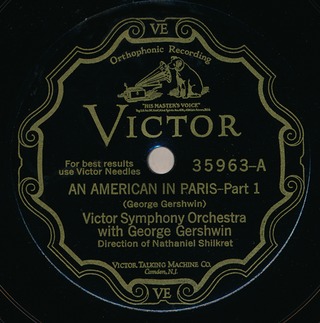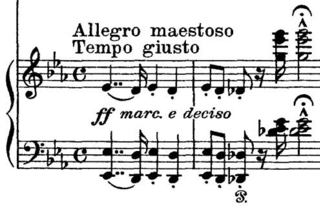
An American in Paris is a jazz-influenced symphonic poem for orchestra by American composer George Gershwin first performed in 1928. It was inspired by the time that Gershwin had spent in Paris and evokes the sights and energy of the French capital during the Années folles.

Orchestration is the study or practice of writing music for an orchestra or of adapting music composed for another medium for an orchestra. Also called "instrumentation", orchestration is the assignment of different instruments to play the different parts of a musical work. For example, a work for solo piano could be adapted and orchestrated so that an orchestra could perform the piece, or a concert band piece could be orchestrated for a symphony orchestra.

Rhapsody in Blue is a 1924 musical composition for solo piano and jazz band, which combines elements of classical music with jazz-influenced effects. Commissioned by bandleader Paul Whiteman and written by George Gershwin, the work premiered in a concert titled "An Experiment in Modern Music" on February 12, 1924, in Aeolian Hall, New York City. Whiteman's band performed the rhapsody with Gershwin playing the piano. Whiteman's arranger Ferde Grofé orchestrated the rhapsody several times including the 1924 original scoring, the 1926 pit orchestra scoring, and the 1942 symphonic scoring.

Ferdinand Rudolph von Grofé, known as Ferde Grofé was an American composer, arranger, pianist, and instrumentalist. He is best known for his 1931 five-movement symphonic poem, Grand Canyon Suite, and for orchestrating George Gershwin's Rhapsody in Blue for its 1924 premiere.

Sergei Rachmaninoff's Piano Concerto No. 3 in D minor, Op. 30, was composed in the summer of 1909. The piece was premiered on November 28 of that year in New York City with the composer as soloist, accompanied by the New York Symphony Society under Walter Damrosch. The work has the reputation of being one of the most technically challenging piano concertos in the standard classical piano repertoire.
In music, variation is a formal technique where material is repeated in an altered form. The changes may involve melody, rhythm, harmony, counterpoint, timbre, orchestration or any combination of these.

The Piano Concerto No. 2 in C minor, Op. 18, is a concerto for piano and orchestra composed by Sergei Rachmaninoff between June 1900 and April 1901. The piece established his fame as a concerto composer and is one of his most enduringly popular pieces.

The Piano Concerto No. 1 in B♭ minor, Op. 23, was composed by Pyotr Ilyich Tchaikovsky between November 1874 and February 1875. It was revised in 1879 and in 1888. It was first performed on October 25, 1875, in Boston by Hans von Bülow after Tchaikovsky's desired pianist, Nikolai Rubinstein, criticised the piece. Rubinstein later withdrew his criticism and became a fervent champion of the work. It is one of the most popular of Tchaikovsky's compositions and among the best known of all piano concerti.
The Cello Concerto in B minor, Op. 104, B. 191, is the last solo concerto by Antonín Dvořák. It was written in 1894 for his friend, the cellist Hanuš Wihan, but was premiered in London on March 19, 1896, by the English cellist Leo Stern.

The Symphony No. 2 in E minor, Op. 27, is a four-movement composition for orchestra written from October 1906 to April 1907 by the Russian composer Sergei Rachmaninoff. The premiere was performed at the Mariinsky Theatre in Saint Petersburg on 26 January 1908, with the composer conducting. Its duration is approximately 60 minutes when performed uncut; cut performances can be as short as 35 minutes. The score is dedicated to Sergei Taneyev, a Russian composer, teacher, theorist, author, and pupil of Pyotr Ilyich Tchaikovsky. The piece remains one of the composer's most popular and best known compositions.
The Piano Concerto No. 3 in E major, Sz. 119, BB 127 of Béla Bartók is a musical composition for piano and orchestra. The work was composed in 1945 during the final months of his life, as a surprise birthday present for his second wife Ditta Pásztory-Bartók.

Franz Liszt composed his Piano Concerto No. 1 in E♭ major, S.124 over a 26-year period; the main themes date from 1830, while the final version is dated 1849. The concerto consists of four movements and lasts approximately 20 minutes. It premiered in Weimar on February 17, 1855, with Liszt at the piano and Hector Berlioz conducting.
Sergei Rachmaninoff composed his Piano Concerto No. 1 in F♯ minor, Op. 1, in 1891, at age 17-18. He dedicated the work to Alexander Siloti. He revised the work thoroughly in 1917.
The Butterfly Lovers' Violin Concerto is one of the most famous Chinese works of orchestral music. It is an adaptation of an ancient legend, the Butterfly Lovers. Written for a Western-style orchestra, it features a solo violin played using some Chinese techniques.

Piano Concerto No. 2 in F major, Op. 102, by Dmitri Shostakovich was composed in 1957 for the 19th birthday of his son Maxim, who premiered the piece during his graduation concert at the Moscow Conservatory. It contains many similar elements to Shostakovich's Concertino for Two Pianos: both works were written to be accessible for developing young pianists. It is an uncharacteristically cheerful piece, much more so than most of Shostakovich's works.
Variations on "I Got Rhythm" is a set of variations for orchestra and piano solo composed by George Gershwin in 1933–34. The piece is dedicated "to [his] brother Ira".

The Piano Concerto in F sharp minor, Op. 20, is an early work of the Russian composer Alexander Scriabin (1872–1915). Written in 1896, when he was 24, it was his first work for orchestra and the only concerto he composed. Scriabin completed the concerto in only a few days in the fall of 1896, but did not finish the orchestration until the following May. Belyayev paid the composer 600 rubles ; it premiered in October 1897 and was finally published in 1898.

Conrad Yiwen Tao is an American composer and pianist and former violinist. Tao's piano and violin performances since childhood brought him early recognition at music festivals and competitions. At age 13, he was featured on the PBS TV series From the Top – Live from Carnegie Hall as violinist, pianist and composer. He won eight consecutive ASCAP Morton Gould Young Composer Awards. Among his compositions have been commissions by the New York Philharmonic, Hong Kong Philharmonic, Pacific Symphony and Dallas Symphony Orchestra.

The Piano Concerto, Op. 40, is a work for piano and orchestra completed by Airat Ichmouratov between 2012 and 2013. Composition remained untouched for a span of ten years until the composer crossed paths with a soloist, Montreal-based pianist Jean-Philippe Sylvestre. Sylvestre's keen enthusiasm for performing the concerto, coupled with his ability to "do it justice and add finishing touches," as described by the composer, led to the revival of the piece. The Piano Concerto was recorded by Chandos on April 19–20, 2022, at St. Luke's in London, with Jean-Philippe Sylvestre as the soloist and the London Symphony Orchestra under the baton of the composer. Its first public performance took place on May 1, 2024, at the Palais Montcalm in Quebec City, with Sylvestre as the soloist, accompanied by the Quebec Symphony Orchestra under Ichmouratov.












